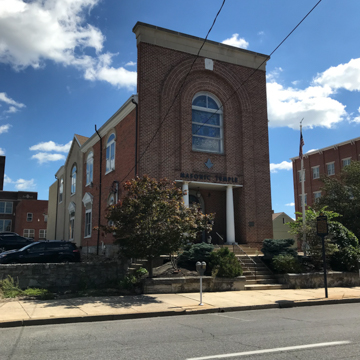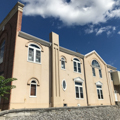Freemasonry traveled west carrying threads of metropolitan design to rural areas. Though designed by a member of the lodge, the simple geometric frame of arches carried on columns in antis suggests roots in Maximilian Godefroy's work in Baltimore. The building was Victorianized after the Civil War probably at the time of the rear addition and was stuccoed over the original brick in 1902. That has since been removed and replaced with dreadful modern Colonial Revival brickwork that largely destroys the integrity of the design. The cubic mass across the street, which is crowned by a tower, houses city offices. Built in the 1830s and enlarged in the 1870s, it was significantly colonialized and further enlarged in the twentieth century.
You are here
Masonic Temple, Washington Lodge, F&AM
If SAH Archipedia has been useful to you, please consider supporting it.
SAH Archipedia tells the story of the United States through its buildings, landscapes, and cities. This freely available resource empowers the public with authoritative knowledge that deepens their understanding and appreciation of the built environment. But the Society of Architectural Historians, which created SAH Archipedia with University of Virginia Press, needs your support to maintain the high-caliber research, writing, photography, cartography, editing, design, and programming that make SAH Archipedia a trusted online resource available to all who value the history of place, heritage tourism, and learning.







